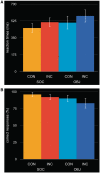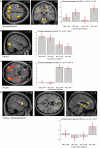Eyes on me: an fMRI study of the effects of social gaze on action control
- PMID: 20705602
- PMCID: PMC3150858
- DOI: 10.1093/scan/nsq067
Eyes on me: an fMRI study of the effects of social gaze on action control
Abstract
Previous evidence suggests that 'social gaze' can not only cause shifts in attention, but also can change the perception of objects located in the direction of gaze and how these objects will be manipulated by an observer. These findings implicate differences in the neural networks sub-serving action control driven by social cues as compared with nonsocial cues. Here, we sought to explore this hypothesis by using functional magnetic resonance imaging and a stimulus-response compatibility paradigm in which participants were asked to generate spatially congruent or incongruent motor responses to both social and nonsocial stimuli. Data analysis revealed recruitment of a dorsal frontoparietal network and the locus coeruleus for the generation of incongruent motor responses, areas previously implicated in controlling attention. As a correlate for the effect of 'social gaze' on action control, an interaction effect was observed for incongruent responses to social stimuli in sub-cortical structures, anterior cingulate and inferior frontal cortex. Our results, therefore, suggest that performing actions in a--albeit minimal--social context significantly changes the neural underpinnings of action control and recruits brain regions previously implicated in action monitoring, the reorienting of attention and social cognition.
Figures




Similar articles
-
The neural correlates of social attention: automatic orienting to social and nonsocial cues.Psychol Res. 2009 Jul;73(4):499-511. doi: 10.1007/s00426-009-0233-3. Epub 2009 Apr 7. Psychol Res. 2009. PMID: 19350270 Free PMC article.
-
A look at actions: direct gaze modulates functional connectivity of the right TPJ with an action control network.Soc Cogn Affect Neurosci. 2019 Sep 30;14(9):977-986. doi: 10.1093/scan/nsz071. Soc Cogn Affect Neurosci. 2019. PMID: 31593216 Free PMC article.
-
Neural basis of social attention: common and distinct mechanisms for social and nonsocial orienting stimuli.Cereb Cortex. 2023 Nov 4;33(22):11010-11024. doi: 10.1093/cercor/bhad339. Cereb Cortex. 2023. PMID: 37782936
-
The reorienting system of the human brain: from environment to theory of mind.Neuron. 2008 May 8;58(3):306-24. doi: 10.1016/j.neuron.2008.04.017. Neuron. 2008. PMID: 18466742 Free PMC article. Review.
-
Infant joint attention, neural networks and social cognition.Neural Netw. 2010 Oct-Nov;23(8-9):985-97. doi: 10.1016/j.neunet.2010.08.009. Epub 2010 Sep 15. Neural Netw. 2010. PMID: 20884172 Free PMC article. Review.
Cited by
-
Social Cues Alter Implicit Motor Learning in a Serial Reaction Time Task.Front Hum Neurosci. 2018 May 14;12:197. doi: 10.3389/fnhum.2018.00197. eCollection 2018. Front Hum Neurosci. 2018. PMID: 29867420 Free PMC article.
-
The effects of context processing on social cognition impairments in adults with Asperger's syndrome.Front Neurosci. 2014 Sep 3;8:270. doi: 10.3389/fnins.2014.00270. eCollection 2014. Front Neurosci. 2014. PMID: 25232301 Free PMC article. Review.
-
Early binding of gaze, gesture, and emotion: neural time course and correlates.J Neurosci. 2012 Mar 28;32(13):4531-9. doi: 10.1523/JNEUROSCI.5636-11.2012. J Neurosci. 2012. PMID: 22457500 Free PMC article.
-
Social learning in humans and other animals.Front Neurosci. 2014 Mar 31;8:58. doi: 10.3389/fnins.2014.00058. eCollection 2014. Front Neurosci. 2014. PMID: 24765063 Free PMC article. Review.
-
Introspective minds: using ALE meta-analyses to study commonalities in the neural correlates of emotional processing, social & unconstrained cognition.PLoS One. 2012;7(2):e30920. doi: 10.1371/journal.pone.0030920. Epub 2012 Feb 3. PLoS One. 2012. PMID: 22319593 Free PMC article.
References
-
- Amodio DM, Frith CD. Meeting of minds: the medial frontal cortex and social cognition. Nature Review Neuroscience. 2006;7(4):268–77. - PubMed
-
- Argyle M, Cook M. Gaze and Mutual Gaze. Cambridge: Cambridge University Press; 1976.
-
- Ashburner J, Friston KJ. Rigid Body Registration. In: Frackowiak RS, Friston KJ, Frith C, et al., editors. Human Brain Function. 2nd. London: Academic Press; 2003. pp. 635–55.
-
- Bayliss AP, Paul MA, Cannon PR, Tipper SP. Gaze cuing and affective judgments of objects: I like what you look at. Psychonomic Bulletin and Review. 2006;13(6):1061–6. - PubMed
Publication types
MeSH terms
Grants and funding
LinkOut - more resources
Full Text Sources
Research Materials

